Episode III: Die HangZhou, Die (German for "The HangZhou, The")
COMPLETED 4/28/06
Anyone who speaks German can't be evil. But what about Chinese?

Traveling by train can be a wonderful experience, especially when your parents are springing for the VIP cabin. The difference between the sleepers is that a standard cabin has 6 bunks, a VIP 4. The VIP has a door. The beds have more padding. And the travelers you'll find yourself sharing this limited space with are much more polite. I've got more thana fair share of stories from less-than-comfortable experiences on trains, but that'll be another post.
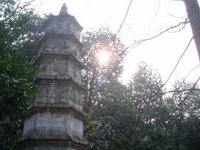 We woke up and pulled into HangZhou on that, my parents' fifth day in China. The night before I had booked a pair of hotel rooms via a brand new booking service. I've whined before about the lack of ability to reserve rooms, so this certainly came as a boon towards my sanity. Especially while breaking in some newbies to China. We still had some worries as we stepped off that train though, as we had no idea how we would get to Hong Kong a few days later. The train that everybody else told me existed didn't exist, so new options needed to be explored.
We woke up and pulled into HangZhou on that, my parents' fifth day in China. The night before I had booked a pair of hotel rooms via a brand new booking service. I've whined before about the lack of ability to reserve rooms, so this certainly came as a boon towards my sanity. Especially while breaking in some newbies to China. We still had some worries as we stepped off that train though, as we had no idea how we would get to Hong Kong a few days later. The train that everybody else told me existed didn't exist, so new options needed to be explored.Before I chronicle any further you must know that HangZhou had been placed on our itinerary for many a reason. Just south of ShangHai, HangZhou stands as one of China's two most 'beautiful' cities, an honor shared with SuZhou ("The Garden City") which is right north of ShangHai. Furthermore, HangZhou sits towards the end of the waterways that transported goods around China during imperial times, leading to a large amount of commerce in the area. You'll find a wealthy supply of silks and a dirth of ceramics and other crafts were you to visit. Most of the town sits around West Lake, a serene body of water that holds a few island gardens, some floating shrines, and ringed by pagoda and temple.
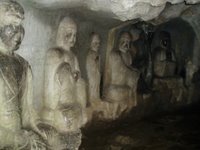 But more than anything else we were going to HangZhou because I had been there before, back during my 1997 trip. Back in that day, HangZhou had been our second stop, right after ShangHai, and it had been little more than a quaint little lake town with a handful of sleepy stores and good deals on silk. We visited a silk factory, a ceramic museum/workshop, a temple, a pagoda, toured the lake on small boats. All in all, very quaint, very quiet, very relaxing.
But more than anything else we were going to HangZhou because I had been there before, back during my 1997 trip. Back in that day, HangZhou had been our second stop, right after ShangHai, and it had been little more than a quaint little lake town with a handful of sleepy stores and good deals on silk. We visited a silk factory, a ceramic museum/workshop, a temple, a pagoda, toured the lake on small boats. All in all, very quaint, very quiet, very relaxing.HangZhou has changed. A lot. Not in any sort of bad way though, in fact, if I can give a testament to the development potential of China, I'd probably use HangZhou. The lake, still quite peaceful, is now lined with bistos, experimental cookeries, high end shopping, funky bars, and an all-around hip vibe. The serene nature of the region hasn't disappeared, they've just BAM! kicked it up a notch. I had hope to give my parent's a flavor of 'real' China, that is the China that isn't all spruced up for tourists,, the China that makes up the large majority of the nation, but, well, who cares. HangZhou is beautiful.
Our hotel (which I don't think was there in 1997) cost only a fraction more per room than our BeiJing lodgings, but could have been the poshest hotel rooms I've ever stayed in. Certainly top 2. Settling in took a while because I wanted to spoil myself with each comfort that had been void ini my life over the previous year. When I finally got pried from luxury, I hit up the front desk to figure out travel arrangements to Hong Kong. Plane tickets were purchased, my Chinese was complimented over and over (yes!), and we hit the streets of HangZhou.
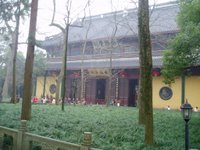 In BeiJing we (we being me) had been successful in staving off shopping excursions till the end of the available time, but in HangZhou we tried to get it out of the way first thing. Not too far from our hotel they've just about finished constructing a little silk commodity village in old-timey architectural style. You've got to bargain, as you do almost anywhere, but the deals will beat anything anywhere else. Plus I found a much higher quality of item, and a larger selection, than I ever found in BeiJing. At least in regards to silk. By the end of the morning I was silk-blind having examined countless scarves. I saw some ties I liked, but they had nothing but the display models, which were stained, so I saved my money for later (I eventually scored some ties).
In BeiJing we (we being me) had been successful in staving off shopping excursions till the end of the available time, but in HangZhou we tried to get it out of the way first thing. Not too far from our hotel they've just about finished constructing a little silk commodity village in old-timey architectural style. You've got to bargain, as you do almost anywhere, but the deals will beat anything anywhere else. Plus I found a much higher quality of item, and a larger selection, than I ever found in BeiJing. At least in regards to silk. By the end of the morning I was silk-blind having examined countless scarves. I saw some ties I liked, but they had nothing but the display models, which were stained, so I saved my money for later (I eventually scored some ties). 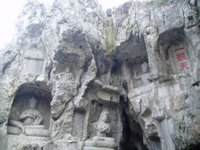 Next up we headed out west from West Lake to LingYin Temple (pardon if I mucked up the name). I had visited this site in '97 and I'm glad I got back. One of the larger temples I've seen, and secluded away from the city in the woods, the outside is ringed with grottoes holding stone carvings of Buddha and all his pals. Inside the temple there are at leaast four large halls strung up the middle, each with gigantic statues of Buddhas and other various gods. The size is amazing alone, but the isn't to say they are delicate nor beautiful as well. You're not allowed to take pictures inside the halls, and I lack the talent to accurately describe what yo'd witness there, so either use your imagination or go yourself. You'll be happy you did.
Next up we headed out west from West Lake to LingYin Temple (pardon if I mucked up the name). I had visited this site in '97 and I'm glad I got back. One of the larger temples I've seen, and secluded away from the city in the woods, the outside is ringed with grottoes holding stone carvings of Buddha and all his pals. Inside the temple there are at leaast four large halls strung up the middle, each with gigantic statues of Buddhas and other various gods. The size is amazing alone, but the isn't to say they are delicate nor beautiful as well. You're not allowed to take pictures inside the halls, and I lack the talent to accurately describe what yo'd witness there, so either use your imagination or go yourself. You'll be happy you did.A new treat at LingYin was the Hall of Arhats which I don't remember from '97 (we were rushed through during that trip, probably not afforded the time to check this out). In a structure to the left of the central walk we found a cross-shaped call holding 500 unique statues, each depicting a different disciple of Buddha. If you've been reading the blog for a while, you might recall these dudes catching my fascination at the Bamboo Temple in KunMing, and sure enough, they succeeded once more in HangZhou. The blend of the surreal with such realistic sculpting defines 'cool' to this adventurer, and again, I wish I could have taken pictures. Alas.
[INTERMISSION: I'll finish the HangZhou entry later, I need to stretch my legs now and get away from the computer. Hang tight.]
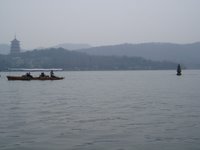 The next few days around HangZhou were filled with relaxed wonder. As I mentioned, the lake area has only gotten hip as all hell, and we took a small boat cruise around to take in the island gardens, the "three pools mirroring the moon," and a few water pagodas that are the most famous of their kind in China. Why, I am not sure, but I have seen other structures of similar build in other locations but no one gave a crap about those. Here, in HangZhou, everyone was gaga for the dealies.
The next few days around HangZhou were filled with relaxed wonder. As I mentioned, the lake area has only gotten hip as all hell, and we took a small boat cruise around to take in the island gardens, the "three pools mirroring the moon," and a few water pagodas that are the most famous of their kind in China. Why, I am not sure, but I have seen other structures of similar build in other locations but no one gave a crap about those. Here, in HangZhou, everyone was gaga for the dealies.After taking in the lake from the boat, we stolled around the better part of it stopping at a few points of interest. Most notably was the tomb of some dude (its been too long and I don't have my notes in front of me so i apologize for the lack of clarity in Mr. Somedude's proper name) which, by this point, was not interesting in the least. For me. After 1+ years of seeing similar sights of greater magnificance. But it was hystrerical knocking on the big holy statue only to come close to tipping it over because all it was was cheap, hollow plastic. Not bronze. Oh, crazy.
 Our last big stop in HangZhou during our last full day there was the Six Wind Pagoda. This was another case of deja vu, as I had visited here back in 1997. This time, though, having all the free time to explore as I wished, I once again found many a thing that captivated me more than the whirlwind tour gave me years back. Most notably, really, only, as there was nothing else I hadn't seen, the Pagoda Garden. What they did here was re-construct, on a much smaller scaller, the 108 (I think) most famous Chinese pagodas. Cool, as I bounded from one to another searching for those I had seen in actuality with my own two eyes. In all, the garden acted like a crib sheet for my own adventures, just in pagoda form.
Our last big stop in HangZhou during our last full day there was the Six Wind Pagoda. This was another case of deja vu, as I had visited here back in 1997. This time, though, having all the free time to explore as I wished, I once again found many a thing that captivated me more than the whirlwind tour gave me years back. Most notably, really, only, as there was nothing else I hadn't seen, the Pagoda Garden. What they did here was re-construct, on a much smaller scaller, the 108 (I think) most famous Chinese pagodas. Cool, as I bounded from one to another searching for those I had seen in actuality with my own two eyes. In all, the garden acted like a crib sheet for my own adventures, just in pagoda form.Eventually we were to leave HangZhou, hopping a plane to Hong Kong. I was not prepared.

0 Comments:
Post a Comment
<< Home